When the Klamath Dams
Come Down
Cal Poly Humboldt researchers are studying the Klamath River as one of history’s largest dam removals begins
by Grant Scott-Goforth
Four longstanding dams on the Klamath River, built to create electricity over the last century, and increasingly controversial for their outsized impacts on the river’s health, will fall over the next year.
CAL POLY HUMBOLDT researchers are working hard on projects up and down the river to gather baseline data now in order to understand what happens once the dams are removed.
The massive deconstruction project will see thousands of tons of materials hauled away to dismantle the four lowest dams on the Klamath—J.C. Boyle Dam, Copco No. 1 Dam, Copco No. 2 Dam, and Iron Gate Dam—along with their associated powerhouses and other facilities.
It’s the culmination of decades of activism, legislation, hard work, and dedication from Native Tribes, environ-mentalists, fish advocacy organizations, and many others.
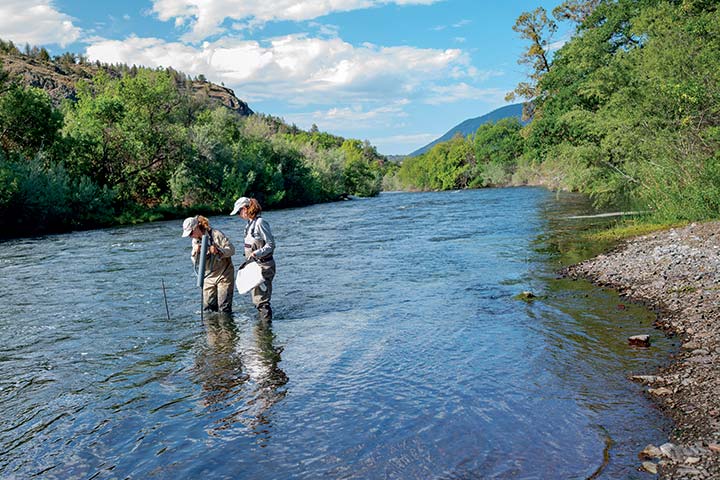
Professor Alison O’Dowd (RIGHT) and Natural Resources graduate student Rosa Cox (LEFT) collect aquatic invertebrates downstream of the Iron Gate Dam to explore the impact of dam removal on river ecosystems.
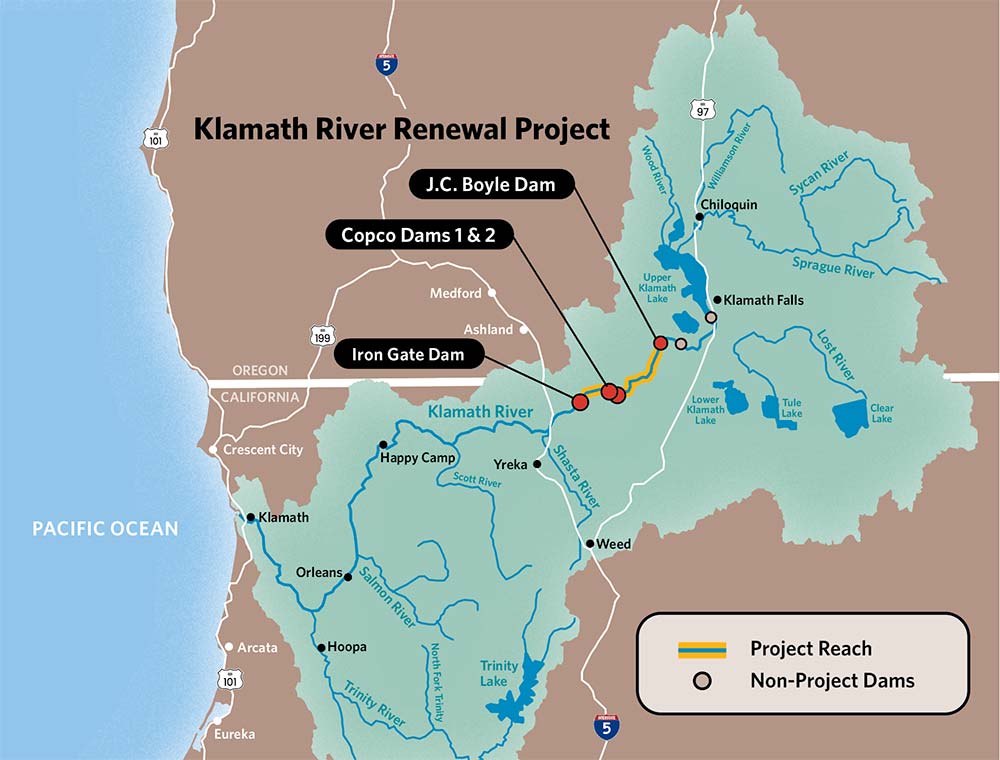
Iron Gate Dam: Built in 1962, Iron Gate Dam is made from earthfill and stands 173 feet tall and 740 feet wide. Preparation to take down the dam, which includes reservoir drawdowns and removing facilities, will begin in 2024.
Copco 1&2: Built in 1918 and 1925, respectively, both concrete dams are scheduled to be removed by the end of 2024. Deconstruction efforts for Copco 2, the smallest of the four dams, began in June, and are slated to be complete in September 2023. Copco 1 constitutes the largest reservoir by area of the hydroelectric dams, at a maximum of 1,000 acres.
J.C. Boyle: Built in 1958, J.C. Boyle is made from earthfill and stands 68 feet tall and 693 feet wide. The dam will be removed by the end of 2024.
THE KLAMATH RIVER is the centerpiece of a sprawling watershed covering nearly 16,000 square miles of Oregon and California. Winding more than 250 miles from the Oregon desert near Klamath Falls, through two mountain ranges, and emptying into the Pacific Ocean in Del Norte County, it’s the second largest river in California after the Sacramento.
The Klamath is a vastly important watershed ecologically, culturally and economically, home for millennia to salmon and trout, migratory birds, a wide diversity of plants, Native people, and, more recently, large scale agriculture, including farms and ranches.
Which has also made it the subject of fierce devotion and dispute.
When the first European settlers descended on the Klamath, they brought with them the ugliest trappings of manifest destiny, violence, subjugation, and an extractive resource ideology.
Perhaps the biggest impact on the river has been the six dams that make up the Klamath Hydroelectric Project, the first of which was built in 1903. The construction of these dams has drastically changed the Klamath River, effectively cutting off some fish runs and wetlands, and affecting water quality that threatens humans, fish, and wildlife.
Native Tribes, the fishing industry, scientists, and environmentalists have sought the removal of the dams for decades, arguing that they have damaged the health of the river, a crucial cultural and ecological resource.
But the dams’ removals are contentious—though the hydroelectric dams being removed are outdated, some see their removal as a threat to the Link River and Keno dams in the upper Klamath region, which farms in the area depend on for water.
This year, more than 20 years after the devastating fish kill, work begins to remove the lower four of the Klamath Dams. The dams being removed are largely seen as inefficient, outdated hydroelectricity producers and are slated to be gone by the fall of 2024. The scale of the removal is massive and the changes to the watershed are expected to be wide-reaching.
The removal also spells hope for the Klamath River watershed, the ecology, and the cultures whose livelihoods and very existence are inextricably linked to the river’s health.
Winding more than 250 miles from the Oregon desert, through two mountain ranges, and emptying into the Pacific Ocean in Del Norte County, the Klamath River is the second largest river in California after the Sacramento.
The Klamath River is a complex, living ecosystem in which everything is interconnected, says Alison O’Dowd, an Environmental Science & Management professor whose work revolves around streams, rivers, and wetlands.
O’Dowd is one of several researchers from Cal Poly Humboldt who are involved in research related to restoration efforts on the Klamath.
O’Dowd, with professor William Trush, is a co-director of the Cal Poly Humboldt River Institute, which was formed in 2012 with a mission to conserve and restore river ecosystems locally, nationally, and internationally through multidisciplinary research, education, policy reform, improved management practices, and creative restoration strategies.
Cal Poly Humboldt is also home to “Klamath Connection,” a place-based learning community for first-year students that consists of courses and activities that focus on the Klamath. The river, which is culturally, environmentally, and economically critical to the North Coast, offers students a unique way to learn about a system through the perspective of different disciplines. O’Dowd also teaches a two-week upper division field course on the Klamath River each summer.
O’Dowd is also one of the scientists involved in the Klamath Basin Monitoring Program, a collective of researchers and organizations that are monitoring the watershed from a variety of topics and angles. The program has been operating since 2006 and consists of dozens of partner agencies and individuals, who can use it as a stockpile of information, a sharing resource, and a planning organization.
The program also compiles data from nearly 1,000 monitoring stations in the watershed, which offer live water quality data and other relevant information, allowing researchers to get a snapshot of the river without having to travel.
That travel can be a burden. The Klamath watershed is huge, and much of the river is in rugged, remote wilderness that is difficult to access.
But the Klamath River draws so much attention because it’s important, and it’s in bad shape.
“There are water quality issues,” O’Dowd says. “The water in the reservoirs gets warm and stagnant, which leads to algal blooms and cyanobacteria. It builds up in high levels, especially in drought years and hot weather, and is worst in late summer when a lot of Tribes have ceremonies that involve contact with the river water.”
“One big impetus for dam removal was the 2002 fish kill,” she says. “In the lower part of the river, crowded conditions, lower water, warmer water, and disease killed a whole generation of fish—approximately 70,000.”
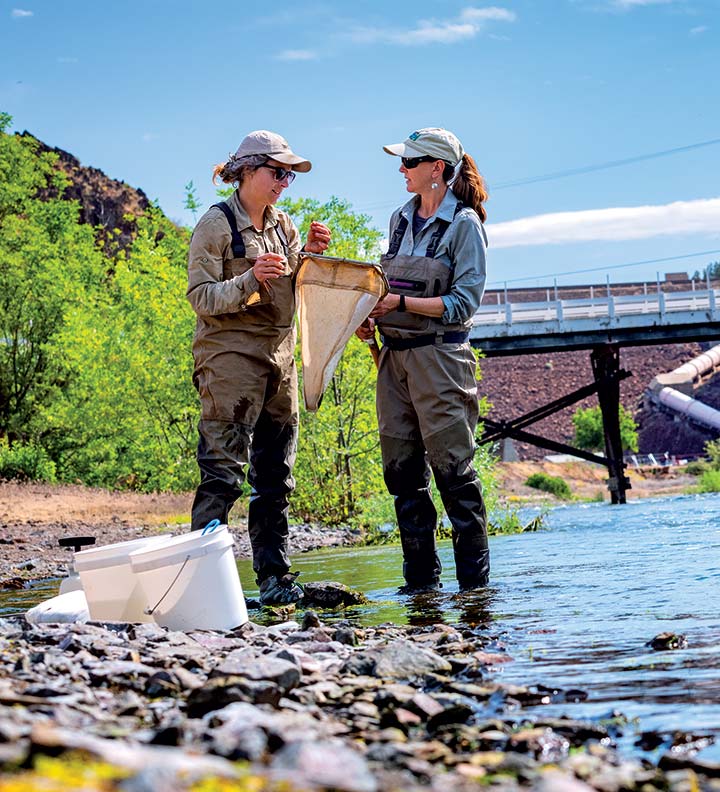
Graduate student Rosa Cox and Professor O’Dowd at one of their sampling sites at Iron Gate Dam.
O’Dowd’s research will examine the impacts of dam removal on aquatic organisms downstream of the dams. During dam removal, high sediment loads will likely reduce visibility and water quality in the Klamath River and potentially impact access to salmon’s primary food—invertebrates. Partnering with scientists at the Karuk Tribe and UC Davis, O’Dowd’s project will sample aquatic invertebrates and juvenile salmonids at Klamath River sites paired with nearby tributary sites to see if salmonids adjust their feeding behavior during dam removal in response to these high sediment loads. Her work will compare these factors over five years; before, during, and after dam removal.
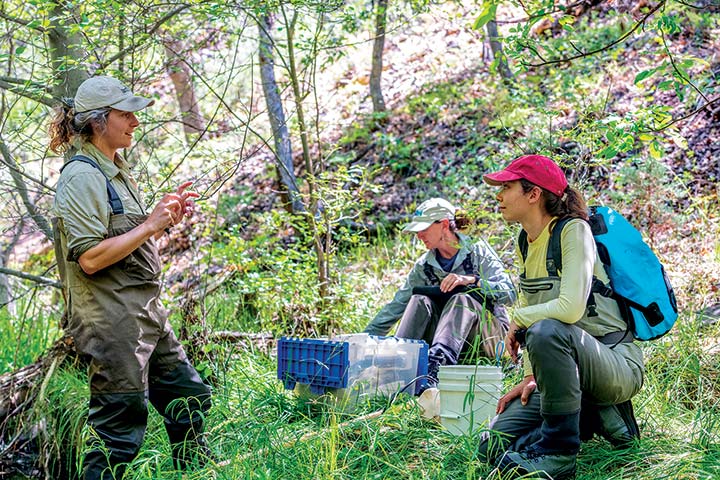
O’Dowd and fellow researchers from Humboldt and UC Davis collect aquatic invertebrates, the main food source for fish, along Bogus Creek, which flows into the Klamath River just downstream of the Iron Gate Dam.
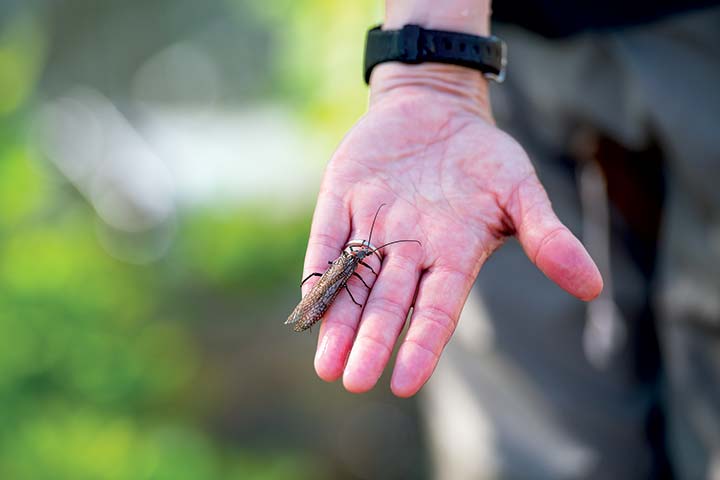
Professor O’Dowd holds an adult salmonfly (Pteronarcys californica) near one of her sampling sites at Iron Gate Dam.
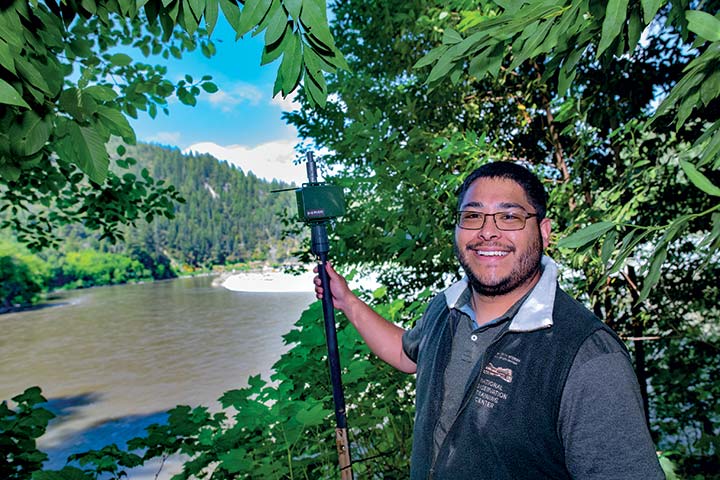
Ryan Matilton monitors bat species using acoustic mini bat ultrasonic recorders in seven different locations along the Klamath River Basin immediately downstream of the Iron Gate Dam to the mouth of the Klamath River in Ter-wer.
Ryan Matilton always thought of himself as an “owl guy.” Graduating from Cal Poly Humboldt with a degree in Wildlife in 2021, he considered eventually going to graduate school. But prior to the end of his undergraduate career came a unique opportunity that he couldn’t pass up: a years-long study of bat species along the middle and lower Klamath River while earning his master’s degree in Natural Resources at Humboldt.
Matilton, a Hoopa Valley Tribal member with Yurok ancestry, was made aware of the opportunity to work on the Klamath bat project through Lonyx Landry, the coordinator for Humboldt’s Indian Natural Resources, Science & Engineering Program (INRSEP) + Diversity in STEM. The program provides academic and research support services to historically underrepresented students in science majors.
With Landry’s help, Matilton began graduate school with Wildlife Professor Barbara Clucas to work on the Klamath bat project. The project is a collaboration with Trever Super and Bronwyn Hogan from the U.S. Fish and Wildlife Service, Scott Demers from the Yurok Tribe Wildlife Department, and bat biologists Ted Weller from the U.S. Forest Service, and Joe Szewczak with the Cal Poly Humboldt’s Biological Sciences Department.
Since Fall 2021, Matilton has worked with the group to monitor bat activity and diversity with ultrasonic recorders at seven locations from Iron Gate Dam to the mouth of the Klamath river. The recorders operate from dusk until dawn, recording a variety of bat calls (and occasionally other noises, which have to be filtered out of the data).
The research is helping to create a baseline of bat diversity and activity prior to dam removal. Bats are a bioindicator species, gauging broad ecosystem health as they are susceptible to stressors and bioaccumulation. The Klamath River is an important food source for bats, which eat insects whose life cycles depend on water. As water flows increase, Matilton expects more natural pools will form, reviving historical wetlands, potentially bringing increased insect populations. Monitoring the presence and activity of bat species in the area can also give an indication of river health.
“They’re viewed with malice, a lot of people view them as pests,” he says. “But they have a lot to teach us.”
“My Tribes believe that we are part of the ecosystem. Some people think if we left nature alone, it would be better off. But we’re stewards, we belong to the Earth and it is our duty and privilege to take care of it for the countless generations to come.”
Ryan Matilton (‘21, Wildlife),
Natural Resources graduate student
While this research opportunity just happened to be in the lead-up to dam removal, Matilton is excited to join the vast network of researchers looking at the Klamath River.
Matilton has a special connection with the Klamath, growing up in the watershed and committing his work and study to the animals the Hoopa and Yurok Tribes share it with.
“My Tribes believe that we are part of the ecosystem,” he says. “Some people think if we left nature alone, it would be better off. But we’re stewards, we belong to the Earth and it is our duty and privilege to take care of it for the countless generations to come.”
Matilton collects an average of 10,000 recordings each month—currently, he is in the process of vetting a total of four terabytes of data. “Data management is the limiting factor of my research,” he says, requiring him to spend large amounts of time sorting and analyzing data with the help of software that can identify bat species by the recorded calls.
Matilton sees himself as a “bat guy” now, despite the fact that they don’t get as much scientific attention and many people find them less charismatic than owls, salmon, steelhead, and other “glamorous” species in the watershed. They’re also difficult to study, given they are small, nocturnal, and make calls mostly in ultrasonic ranges that people can’t hear.
Natural Resources master’s degree student James Whelan is looking at Chinook salmon survival rates on the far upper reaches of the Klamath around the Keno and Link River dams—two dams that will remain.
Both of those dams have fish ladders, allowing migratory fish, such as salmonids, to navigate upstream beyond the dams. While there’s a lot of study regarding adult fish swimming upstream, there’s not much research about Upper Klamath basin juvenile fish passing downstream on their way to the ocean.
To measure this, they surgically implanted about 200 fish with radio tags and set up seven stationary receivers throughout a stretch of river. They also conduct mobile tracking on boats, where they can traverse the river system, looking for signals that indicate where the fish are. Whelan continues to collect data for the current 2023 field season as well.
“So far so good,” Whelan says. “We’ve seen some really good results—the Keno and Link River dams don’t seem to have much of an effect on fish moving downstream, and there were high survival rates from above to below the dam. It was really great to see.”
Whelan grew up in the Rogue Valley near the upper Klamath, so he’s closely familiar with the river and the complicated water politics of the agricultural region, as well as the discussions about dam removal that have pervaded the area in recent decades. As kids, he and his friends would share urban legends about swimming in the algae-choked river.
“We always knew the water quality was awful,” says Whelan. When he had an opportunity to conduct graduate research on the river, he jumped at the chance.
Whelan praised the agencies involved for their collaboration with a broad array of people on the contentious topic, and has developed his own diplomacy for people who are against dam removal: “Wouldn’t it be cool to catch salmon on the Upper Klamath?”
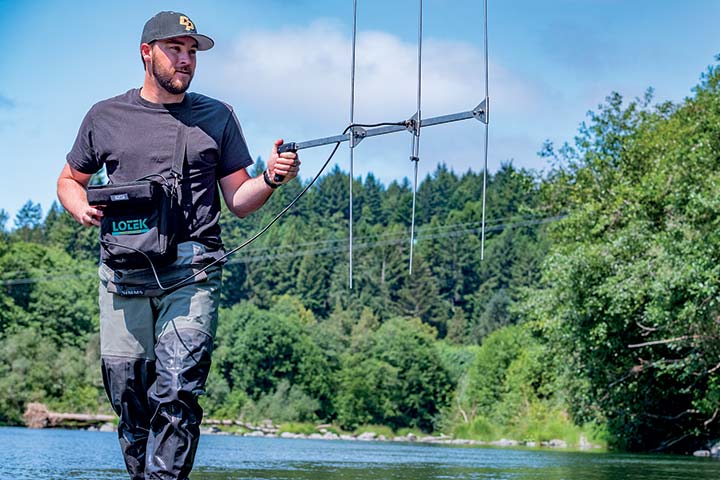
Natural Resources graduate student James Whelan uses a hand-held antenna to mobility track and locate signals from radio tags implanted on fish.
Researchers will continue to examine the Klamath River, and there’s excitement and hope for the river’s health, despite the years of damage. Some salmon runs are on the brink of extinction, and it’s unclear if their populations may rebound. But the downstream impacts of dam removal will be diverse, and may hold surprises.
“We don’t have specific predictions about what is going to happen,” says Clucas. “We might see no change at all in a year, it might take ten years to see changes in the ecosystem.”
The research taking place has implications for climate, marine mammals, marine and migrating birds, redwood tree health, endangered wildlife, native plants, and a multitude of human health, social, and cultural impacts. It sets the stage for greater understanding of the region and similarly affected watersheds worldwide.
Future research projects can use the data that current Cal Poly Humboldt researchers are collecting to measure possible impacts of the dam removal process, and long-term impacts of the river restoration, giving insight into best practices for watershed restoration around the world.